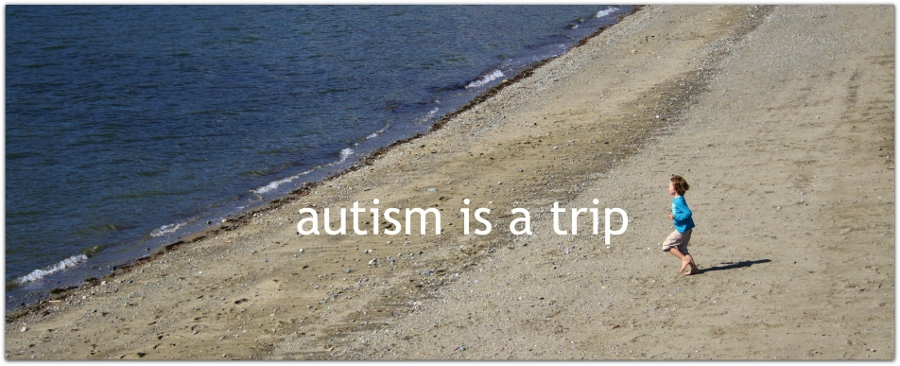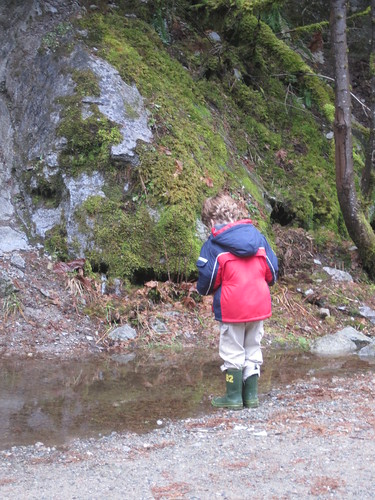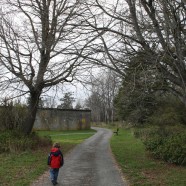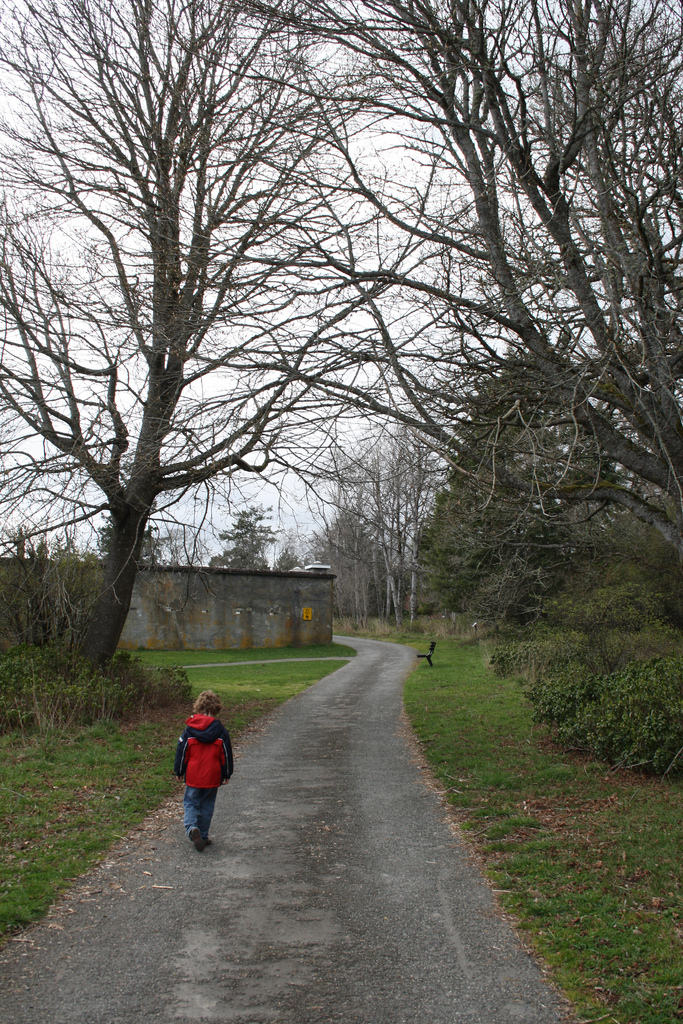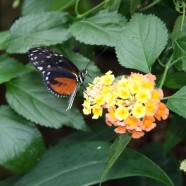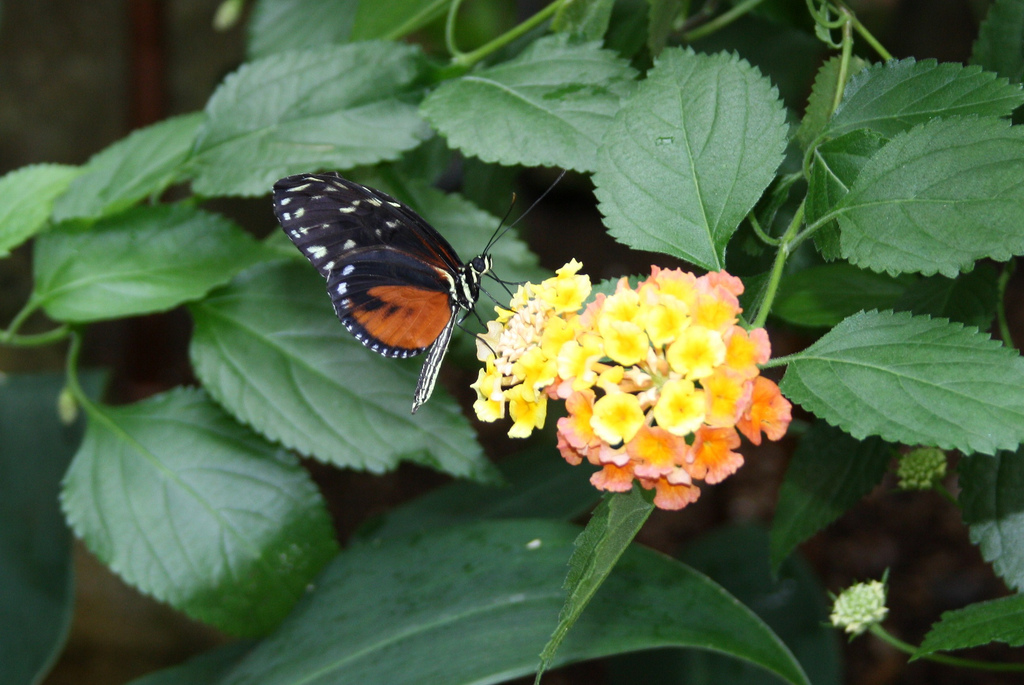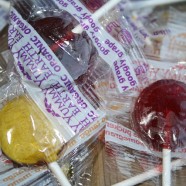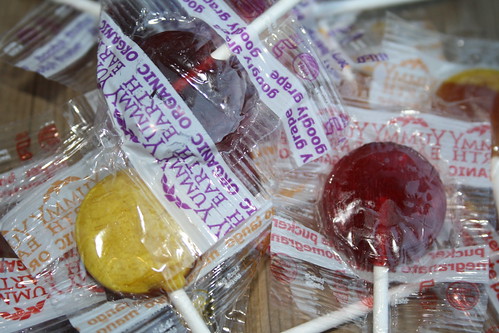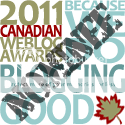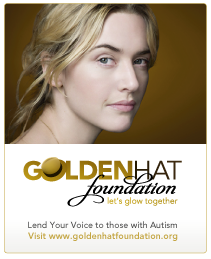I'm Impressed. Really.
One of the hallmarks of autism is an apparent lack of emotional engagement in the outside world. Autistic individuals often seem to regard happenings and others passively, with little or no reaction, even in an emotionally charged situation.
Thankfully Jack is rich with outward emotion (even though it may not always be the appropriate one). While he has feelings just like any other child, he’s had to learn how to express them properly, just like he had to learn proper speech patterns.
Watching him work things out like that fascinates me. I love to ask him questions, like “did you enjoy that walk we took?” or “how did you feel when your brother finished a puzzle all by himself?” I want to see if what he was experiencing inside jibed with how he physically reacted. More and more, the two are aligning.
As much as I love being involved in his learning processes, I’m starting to think my innocent queries are wearing on Jack.
We took a drive through the mountains a few weeks ago, and the melting snow made waterfalls all along our route. The boys were giddy trying to find them all. After a while, they grew silent.
“Jack, are you still looking out the window? What do you see?” I asked.
“I saw the waterfalls and I said ‘ooooh’ to them,” he snapped back.
Well alrighty then. Perhaps I should find a less obvious way to be all up in my son’s emotional development.
Share this: Twitter | StumbleUpon | Facebook | digg | reddit | eMail Read MoreYou are Me as We are All Together
There is an evolution of language acquisition. Children learn the parts of speech in fits and starts, usually in the same order as other kids. So what happens when your child simply doesn’t speak before age two or three, and has to be taught everything, rather than pick it up themselves naturally? Curious things, I tell you. Curious things.
As I’ve mentioned before, Jack had only about four words by age two (although looking back at video I can make out a few more that we didn’t pick up on at the time). Due in large part to the awesome Miss Amanda, speech therapist extraordinaire, he began speaking in earnest not long after his therapy started.
Unlike Jack’s siblings, he had no “baby talk.” He skipped that part and went straight for the gold. He had his cute mispronunciations, of course. One of our all-time favourites is “helicopter,” spoken like a tiny Frenchman as “ell-ee-oh-cop-tayr.” For the most part, though, he simply picked up what Amanda was putting down, and went with it.
As a self-proclaimed word geek, I loved seeing Jack’s language unfold. I had always dreamed of having conversations with my child, as every mama does, and for the first time it was happening. And it was happening in a completely unique way.
Lots of small children confuse proper pronouns and genders and tenses. English is an extremely difficult language, even if it is your native tongue. Jack is no exception, although he had to learn the difference in genders through play. Everyone was a boy for a very long time. In fact, it was only recently that his favourite train Julia became the girl she was meant to be.
One of the hardest concepts Jack dealt with was with proper pronouns. He referred to himself as “you” for quite some time, much to the confusion of others. Having a conversation with him was a convoluted affair, trying to figure out which “you” he meant when.
Jack: “You’re going for a walk.”
Me: “No, *you’re* going for a walk.”
Jack, exasperated: “Yes. You’re going for a walk.”
You see where this is going.
As he learned, he started putting his own spin on things. He worked out who exactly “you” was in proper context, and eventually stopped calling women “him.” He even started naming toys and playthings.
This summer we scored a couple of big car hauler trucks at some rummage sales, and adding in the two smaller ones we had at home, Jack created a car hauler family. He named them Mom, Dad, and Baby (both of the small ones were named Baby). Several times I have run from one end of the house to the other after hearing a frantic “Moooommmm!!!” only to find an infant truck in search of its mother. Repeated pleas to change their names have fallen on deaf ears.
Most of the quirks in Jack’s speech are gone now, as he’s five-and-a-half (what?!?) and on to learning French. Now he’s mixing both languages as he’s learning, and it’s hard to recall the days when he barely spoke at all. It’s not something I ever want to forget.
Share this: Twitter | StumbleUpon | Facebook | digg | reddit | eMail Read MoreWhy I Don’t Hate Autism
I read a fascinating article recently by K at Floortime Lite Mama, posted on the Hopeful Parents website (both sites you should check out, btw). The article, “Why I don’t hate autism, and neither should you?” piqued my interest.
I read the words K wrote, nodding along as if we were having a conversation. I have had that conversation, in fact, with many people. I love finding a kindred spirit in this crazy community we’ve found ourselves a part of, someone who can laugh at the absurdity of it all. I smiled and nodded, that is, until I reached the bottom. I was wholly unprepared for the anger in the comments section.
Some of the commenters were in agreement and supportive. Some didn’t agree, but understood her point of view. The others, though, were downright angry and offended. Angry that someone dare tell them to not hate the thing that had wrought such havoc on their lives. Offended that there are some who willingly embrace autism as just another facet of reality. Angry and offended that someone dare tell them they need to embrace neurodiversity and not be hurt and sad and disenfranchised and devastated by autism.
There are a lot of families touched by autism who cannot see their way past the anger. They cannot not hate autism. I get that. I was there. There are days I find myself screaming the same thing at the top of my mental lungs – I. Hate. Autism.
But in truth, I don’t.
As you are well aware, my family approaches life with a smile and an eagerness to laugh. We do not hate autism, rather, we are thankful for the perspective it has given us. We are acutely aware of how “lucky” we are in that our child is not profoundly autistic, and we do not face a lot of the same challenges other families face daily. This does not change the fact that we still deal with autism. There is no “good” or “bad” autism, just the same autism, in varying degrees.
There are days I want to pull my hair out. There were weeks on end over the last few months where I thought we were backsliding to the early days, and we might never have a “normal” life. You know, a life that doesn’t involve 4 people always bowing to the will of one. A life where an older brother doesn’t constantly terrorize his two younger brothers every time they dare play with a toy he wants (which is whatever they have at any given moment). A life that doesn’t have me counting down to bedtime from the minute I wake up every morning.
In addition to the trials and tribulations within the confines of my own home, I watch my friends dealing with their own ASD and SPD children, some with more than one in the home. Autism doesn’t just affect the family itself, it affects the entire community. It takes a village, you know, and if the village is full of angry, hateful people, what does that tell the children?
Many children with autism do not appear to have outward emotion, but they do, in fact, feel. And they perceive how the people around them feel, sometimes more intensely than we give them credit for. Do we want to raise these individuals to hate the very thing that defines them, or to accept it and learn to adapt?
I’ve said it before, and I’ll say it again: autism is infuriating, inconvenient, aggravating and exhausting. Autism is also incurable. That leaves us with a very important decision. Do we live a life of anger and resentment, or do we accept that we have a more complicated life than expected and deal with it?
I am in no way suggesting that a life with autism is a bowl of cherries for either the individual or their family. What I am suggesting is we have a choice in how we deal with it. And we have a responsibility to the individual with autism in our lives to set an example.
So what will you choose? I want Jack to laugh and be happy, and to see his autism as just another thing to deal with, like my terrible eyesight or his daddy’s left-handedness. No, they’re not the same thing, but I can’t see any harm in Jack owning who he is and going with it.
Having a child with autism means having autism in the family. You don’t have to love it, but life might be a little easier if you didn’t hate it.
Share this: Twitter | StumbleUpon | Facebook | digg | reddit | eMail Read MoreA Naturally Colorful Life
We are a dye-free family. Yes, I am one of “those” moms. I’m the mom who won’t let her kid have Kool-Aid at the party. I’m the mom who has to take every snack innocently offered at the playground and inspect it with a scientific microscope first. I’m the mom who will not, under any circumstances, make an exception “just this once.”
Before you write me off as obnoxious and over-protective, let me tell you my story. At the tender age of three, I became, as my father likes to tell it, a “nightmare.” According to my mother, I was given some candy by a well-meaning relative and had somewhat of a reaction. And by reaction, I mean a full-on personality change. I was what they used to call “hyper.” The change was so marked that my mother took me to the doctor, and I was diagnosed with “hyperkinesis,” the early 1970’s version of ADHD.
I don’t know exactly how it all went down, but someone had the wherewithal to realize it was the colors in the candy (red, specifically) that were causing my erratic behavior. My mother tended toward the natural side of things, and she discovered the work of Dr. Benjamin Feingold, and his book, The Feingold Diet. Dr. Feingold hypothesized that artificial colors, artificial flavors and additives (like BHA, BHT and salicylates) were major contributors to childhood hyperactivity. At the age of six, my mother attempted to put me on The Feingold Diet.
I was all for it, in theory. I loved the attention, the “special” foods and the prizes she dangled in front of me as inspiration to stay on the diet for any length of time. Looking back, I think we were doomed to fail. By the time she implemented the diet in force I was already addicted to candy. To be fair, there was no way the “healthy-tasting” alternatives were ever going to win over Fruity Pebbles and grape Bubble Yum. There was not the bountiful array of alternatives we have today, and seriously, carob is no substitute for chocolate. I was a lost cause, and my childhood was often a haze of erratic, candy-fueled behaviors.
I have known my entire life that consuming artificial ingredients is “bad” for me, but it took puberty to make me quit them completely. Sure, candy and sodas made me moody and unpredictable, but that was mostly inconvenient for those around me, so I didn’t really care. I realize now I was no more able to control my chemical consumption any more than an addict can control their need for drugs. I needed a massive intervention, and thankfully, one came naturally. Around the age of seventeen my beloved red sodas and purple gum and rainbow-hued candies turned on me.
As a child and young teen, the chemicals jacked me up. They wired me for sound. I couldn’t really focus or function to the best of my abilities, but I wasn’t calling the shots. I remember vividly the day six little gumballs came in the mail, promising a wonderful new world without sugar. Those gumballs were my first taste of aspartame, marketed at the time as Nutrasweet. The reaction I had to aspartame was essentially everything I’d experienced before, turned up to eleven.
Then, something happened. I’m guessing my hormones changed, and so did my body’s reaction to the junk I’d been feeding it. Instead of feeling awesome when I had a Hawaiian Punch at school in the morning, I felt ill. My tongue felt thick and burned, I felt lightheaded and sick to my stomach. I had to make a massive change in the way I was eating, and I had to do it quickly.
Fast forward to today. I have lead a mostly all-natural life for the last 24 years. In that time I’ve watched our society’s attitude toward food change drastically. In the beginning if I wanted something other than fruit juice or water to drink, my only choice was Snapple. All-natural hard candies were next to impossible to find, except the awful ginger candy at the health food store (all apologies to those who love ginger candy – I just can’t do it). Nowadays you can find a natural alternative to almost anything you’re craving, from soda to candy to snack cakes.
I’ve watched the food supply get overrun by chemicals, and not just colors, flavors and additives. Now we have, in addition to aspartame, a whole host of imitation sweeteners, MSG, growth hormones in meat and dairy products, and High Fructose Corn Syrup (HFCs*) pushing natural ingredients to the wayside. To make matters worse, most HFCs (at least in the USA) is made from genetically-modified (GMO) corn (there may not be a lot of research around GMO food yet, but I can’t see how messing with the DNA code of a plant to produce a sort of Frankenfood can be good in the long run). Think I’m wrong? Take a walk through your neighborhood conventional grocery store and pick something off the shelf. Anything. I’ll bet you it contains HFCs. Bread. Deli turkey. Tomato sauce. Cereal. It’s pretty hard to regulate your sugar intake when there are added sugars in every single item in your shopping cart. The purpose of HFCs is supposedly to substitute for sugar, but in reality it is used most often in addition to other sugars, and the more sugar you eat, the more you want to eat. Pretty handy for the manufacturers.
The biggest secret about artificial colors especially is the ingredients used to make them. Food dyes approved for mass usage commonly contain trace amounts of lead, azo and tartrazine (coal tar derivatives), aluminum, and many other ingredients that are potential carcinogens and asthmatic triggers.
Sure, in the last few years “all-natural” has become the fashionable thing to do. However, unless you shop at Whole Foods or Trader Joe’s or Wild Oats or Sevananda or another store that only carries “real” natural and/or organic foods, you can’t be certain you’re actually getting a natural product. Case in point – on a recent trip to Costco, I looked at Dempster’s Ancient Grains bread, chock full of whole grains and certain to be the real deal. Nope. Every Dempster’s product contains HFCs. In fact, it was only in the last few years that Oro brands, one of the staples of mass-produced “natural” breads, eliminated HFCs from their ingredient lists. My point is don’t assume anything, and read everything.
I have spent my life reading labels. I read every single label on every single food item I buy. I used to spend hours grocery shopping. I am now a one-woman resource on food ingredients, a crown I am proud to wear.
I have always said that when I had children, they would not eat artificial foods at all. Everyone has things they will and won’t do as parents, and much of it is fantasy (how many of us swore *we* wouldn’t be the ones with the screaming child in the restaurant?) Well, I kind of knew better on that front, but I had visions of my own. Call me crazy, but I just don’t think children need blue ketchup or green yogurt or cereal with candy in it, and I was determined to keep those things out of our home.
The fantasy I have for my children is that they will know the difference between junk and real food. It’s a long shot, but I’ve been working really hard for the last five years to make it happen. We are fortunate that the first years of our young family were spent in Southern California, where eating naturally is the norm, and Whole Foods and Trader Joe’s are on every corner. We easily created habits for a lifetime that can persist even when we’re in less “food friendly” regions.
I was determined to create an all-natural family long before I knew my first born son had autism. Before I knew how critical my choice would actually be for his well-being. I gave him the best shot at “normalcy” without even knowing it (and that’s just my opinion – I mean no offense to anyone who has fed their child conventional foods).
There has been a lot of research lately about artificial ingredients and how they affect behavior in children, but I can tell you I’ve witnessed it firsthand. I know exactly when Jack has had something “bad.” He had a half of a red cookie in preschool once and he tantrumed the whole afternoon after throwing a Sybil-like fit. On Halloween this year he had a cupcake with an orange candy on it and he was unable to sit still or control himself until late that night. I have watched my child go from happy and calm to erratic and moody in the time it takes to chew a Skittle. I can only imagine what I put my parents through eating that stuff on a regular basis.
These ingredients affect my neurotypical children as well. If Kieran or Lennon get their hands on something artificial, you would be hard-pressed not to wonder if they, too, fall somewhere on the spectrum. They become irritable, scattered, and just generally hyper, if you will.
I have endured criticism from many about how I choose to feed my children, but really, is it so bad to insist my kids eat actual food? My children are far from deprived. They have as much candy as the next child (too much), it’s just colored and flavored with fruit juices and vegetables. As a former candy junkie, I can attest to the yumminess of it, too. My children get jell-o, I just make it myself out of gelatin and fruit juice. We make brightly-colored cookies at Christmas and Easter and Halloween and Valentine’s Day. Because I am so vigilant about what they eat 98% of the time, it’s no big deal if they get an Oreo or a HFCs-laden McDonald’s hamburger every once in a while (but, like I said, previously, I make NO exceptions for colors, ever).
I put a bag of “approved” lollipops and other treats in Jack’s school backpack for parties and other treat days so he will always have something, too. I check with birthday party hosts ahead of time to see what kind of cake is being served, and bring cupcakes for my kids if necessary. I carry natural treats and snacks with me all the time “just in case.”
In return for my diligence, my kids are happy, healthy, and beginning to understand the difference between good and bad foods. In the candy aisle the other day, Lennon pointed to a bag and said, “that’s colors, and we don’t eat that.” On Halloween they were patient as I weeded through all of their loot to take out the “yucky” stuff (I always buy extra “good” stuff ahead of time to supplement what I’ve removed, and we use the offending candies to decorate our gingerbread houses at Christmas). I don’t see them pining for anything they think is “forbidden” to them. That’s key in my mind, as children inherently want what they’re not allowed. By explaining that those things are “not food,” they understand. It helps, too, that both myself and my husband eat this way as well. We don’t have “mommy and daddy food” and “kid food.” In our house, it’s just food, and it’s all good.
I know that someday soon my children will have to make these choices for themselves, and I’d be lying if I said it didn’t scare me. I can only hope that by normalizing natural eating and not stigmatizing it, they will make smart decisions. And if they don’t, they can stay in their rooms until they’re fit to be around again.
*in Canada, HFCs is called “glucose-fructose”
************************
**UPDATE 7/1/2012
Recently, in our quest to get Jack properly diagnosed here in Canada, I gave him a bag of Skittles before an assessment. You know, to “bring on some autism” – to ensure he’d display some behaviors worth documenting. Not only would he NOT eat them (“Mom!! I can’t eat these!! They have colors!!”), when I tried to sneak them into a bag of all natural jelly beans, he methodically picked out every offending candy and gave them back to me. I was disappointed, but so, so proud.
He did fine in his assessment, by the way.
Share this: Twitter | StumbleUpon | Facebook | digg | reddit | eMail Read MoreI Forgot to be Sad
Someone said something that struck me in my heart of hearts last night. I was chatting with several people about Temple Grandin on Facebook, and realized that evidently she is not as well-known here in Canada as she is in the USA.
Dr. Temple Grandin, for those of you unfamiliar, is an amazing autistic individual who inspired a HBO movie starring Claire Danes. Her story has, in my opinion, almost completely changed the autism conversation. She is a brilliant person who has broken barriers as a woman, as a scientist and as a person with autism.
Claire Danes has won many accolades for her portrayal of Temple, and she just received a Golden Globe at this year’s ceremony. One of my Canadian friends pointed out that while the movie seemed to be winning a lot of awards, she had no idea who or what Temple Grandin is. I was surprised. In the United States, Temple’s story has been heralded for over a year now. In Canada, however, HBO is not as pervasive as it is in the US, and a lot of their programming gets lost in the shuffle.
After I explained who Temple is, another commenter joined in. “She has autism? That’s so sad.”
This comment struck me sharply and immediately. To begin with, it was obvious to me that this person, who did not know me or my experiences with autism, had no idea what Temple has accomplished. To use the word “sad” in the same sentence with her seemed completely off to me.
Then I realized that this comment was affecting me much more than just abashment at someone not understanding the greatness of Temple Grandin. The immediate need to feel sadness for someone with autism, without knowing anything else, brought tears to my eyes.
Autism sucks. Autism is stressful, it is chaotic, it is nerve-wracking. Autism can quickly turn an easy day hard and render simple outings impossible. Autism affects entire families, not just individuals, and it is selfish.
And yes, for a lot of families, autism is devastating. There are individuals so locked inside themselves they cannot have meaningful relationships or lead productive lives without elaborate intervention.
For a lot of us, though, autism is also a magical, wonderful thing. Autism has given my child the eyes to see things no one else around him can see. Autism has helped me reach inside myself and find wells of patience I didn’t think I possessed. Autism has made our family flexible, but stronger than I ever could have imagined.
When I realized for the first time that Jack was, in fact, autistic, I cried.* I raged at the loss of a life that never was, never would be. I stayed in a cocoon for several days and emerged transformed, looking at the world in a new light. It’s been just over two years since we got his “official” diagnosis, and now autism has a cozy spot in our home. Autism is an unlikely passenger in our lives, one we never expected to join us, but one we couldn’t imagine not having around now.
And somewhere along the way I forgot to be sad. I think it’s shocking to me that someone’s initial reaction to autism is sadness, but then, they don’t know my child. They don’t know my life. Their eyes haven’t been opened to the things we see every day and used to overlook.
*Read “Jack’s Story” for the entire story
Share this: Twitter | StumbleUpon | Facebook | digg | reddit | eMail Read More